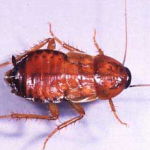-
The Oriental roach is also known as the waterbug partly because it is most often associated with damp and moist places. This bug is one of the larger peridomestic roaches and is most often found in lower lying areas of the home such as basements or crawl spaces. Homes with high humidity, chronic leaks, sump pumps, thick vegetation or leaf debris around the exterior are most prone.

- Often times the Oriental roach is under estimated as serious pest but it can present a real challenge and be very persistent. This scavenger feeds on just about any kind of filth and is especially fond of garbage and scraps. Food contamination is always of concern as this roach passes germs or pathogens it picks picks up in its unsanitary conditions and then comes in contact with food or food contacting surfaces.
Oriental roaches can go for about month without eating but only 2 weeks without water. Not as prolific as other roaches the Oriental female produces about 200 offspring and once becoming an adult, may live from 5 to 26 weeks. Capsules, called oothecas are carried by the female for a short time and then dropped in a secure place and near a food supply. These ootheca contain an average of 16 eggs which take about 60 days to hatch on average. Nymphs, molt 7 to 10 times and the time between birth and a mature roach can take 24 to 130 weeks. The cycle of this roach is somewhat centered around seasons and peak activity is late spring and summer which is not the case with other home infesting roaches.How They Travel
This roach is seldom found in walls, does not fly and is somewhat slow and clumsy. This roach can be transported in bulk truck loads of dirt or mulch. Warehouses that have this roach present will often ship goods in boxes where this roach has crawled inside to hide or in search for food.
How Best To Identify Oriental Roaches
The oriental roach is about an inch in length, very dark brown to black in color and shiny in appearance. Females are larger than males and have wing pads but no wings. Males have wings that cover about 2/3’s of their abdomen. This roach is ‘thick’ and heavy as roaches go. When crushed the roach emits a putrid odor.
Family pest control serving Ocala for over 25 years

Leave a Reply